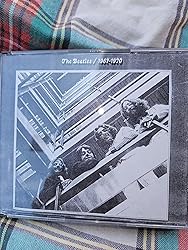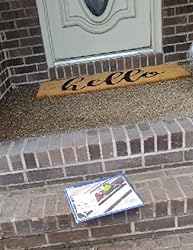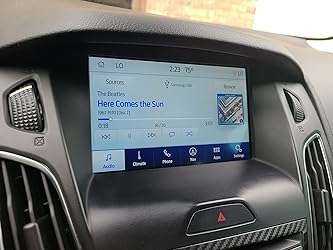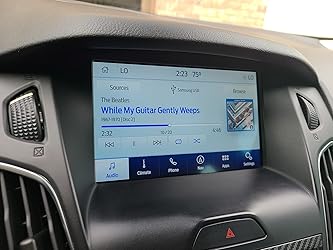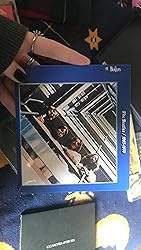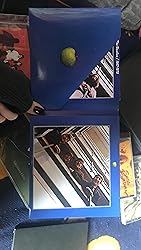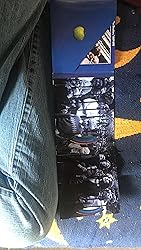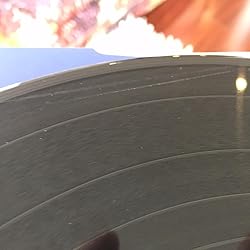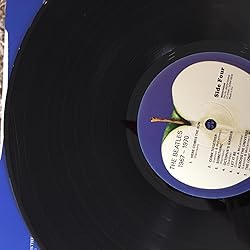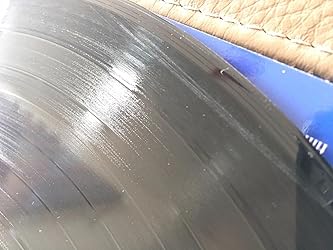Image Unavailable
Color:
-

-
-
- Sorry, this item is not available in
- Image not available
- To view this video download Flash Player
1967-1970
LP, Compilation
Learn more
- Free returns are available for the shipping address you chose. You can return the item for any reason in new and unused condition: no shipping charges
- Learn more about free returns.
- Go to your orders and start the return
- Select the return method
- Ship it!
Learn more
- Free returns are available for the shipping address you chose. You can return the item for any reason in new and unused condition: no shipping charges
- Learn more about free returns.
- Go to your orders and start the return
- Select the return method
- Ship it!
Learn more
- Free returns are available for the shipping address you chose. You can return the item for any reason in new and unused condition: no shipping charges
- Learn more about free returns.
- Go to your orders and start the return
- Select the return method
- Ship it!
| Listen Now with Amazon Music |
|
The Beatles 1967 - 1970 (Remastered)
"Please retry" | Amazon Music Unlimited |
| Price | New from | Used from |
|
MP3 Music, April 2, 1973
"Please retry" | $18.99 | — |
|
Audio, Cassette, October 5, 1993
"Please retry" | — | $13.29 |
-
90 days FREE Amazon Music. Terms apply.
90 days FREE of Amazon Music Unlimited. Offer included with purchase. Only for new subscribers who have not received offer in last 90 days. Renews automatically. You will receive an email to redeem. Terms apply. Offered by Amazon.com Shop items
Frequently bought together
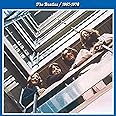
Similar items that may ship from close to you
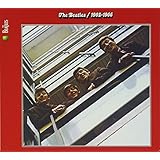 The Beatles: 1962-1966 (The Red Album) (2CD)Audio CDFREE Shipping on orders over $35 shipped by AmazonGet it as soon as Saturday, Sep 30
The Beatles: 1962-1966 (The Red Album) (2CD)Audio CDFREE Shipping on orders over $35 shipped by AmazonGet it as soon as Saturday, Sep 30 Abbey Road AnniversaryVinylFREE Shipping on orders over $35 shipped by AmazonGet it as soon as Saturday, Sep 30
Abbey Road AnniversaryVinylFREE Shipping on orders over $35 shipped by AmazonGet it as soon as Saturday, Sep 30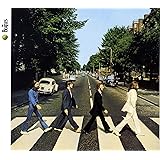 Abbey Road (Remastered)Audio CDFREE Shipping on orders over $35 shipped by AmazonGet it as soon as Saturday, Sep 30
Abbey Road (Remastered)Audio CDFREE Shipping on orders over $35 shipped by AmazonGet it as soon as Saturday, Sep 30 Rubber SoulVinylFREE Shipping on orders over $35 shipped by AmazonGet it as soon as Saturday, Sep 30
Rubber SoulVinylFREE Shipping on orders over $35 shipped by AmazonGet it as soon as Saturday, Sep 30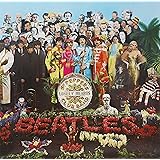 Sgt. Pepper's Lonely Hearts Club Band 2017 Stereo MixVinylFREE Shipping on orders over $35 shipped by AmazonGet it as soon as Saturday, Sep 30
Sgt. Pepper's Lonely Hearts Club Band 2017 Stereo MixVinylFREE Shipping on orders over $35 shipped by AmazonGet it as soon as Saturday, Sep 30
From the brand

Track Listings
Disc: 1
| 1 | Strawberry Fields Forever |
| 2 | Penny Lane |
| 3 | SGT. Pepper's Lonely Hearts Club Band |
| 4 | With a Little Help from My Friends |
| 5 | Lucy in the Sky with Diamonds |
| 6 | A Day in the Life |
| 7 | All You Need Is Love |
| 8 | I Am the Walrus |
| 9 | Hello, Goodbye |
| 10 | Fool on the Hill |
| 11 | Magical Mystery Tour |
| 12 | Lady Madonna |
| 13 | Hey Jude |
| 14 | Revolution |
Disc: 2
| 1 | Back in the U.S.S.R |
| 2 | While My Guitar Gently Weeps |
| 3 | Ob-La-Di, Ob-La-Da |
| 4 | Get Back |
| 5 | Don\'t Let Me Down |
| 6 | The Ballad of John and Yoko |
| 7 | Old Brown Shoe |
| 8 | Here Comes the Sun |
| 9 | Come Together |
| 10 | Something |
| 11 | Octopus's Garden |
| 12 | Let It Be |
| 13 | Across the Universe |
| 14 | The Long and Winding Road |
Editorial Reviews
Limited import reissue double 180-gram vinyl LP. All you need is love... and the greatest hits of The Beatles' later years. This classic Beatles compilation spanning the years 1967 - 1970 (A.K.A. The Blue Collection) has been cut from the original analog masters and the packaging is faithful to the original artwork. Sing along with Sgt. Pepper and the Walrus on Penny Lane or in Strawberry Fields. Get Back, Jojo, to the psychedelic sounds of The Beatles' most cutting-edge music. It\'s time to take that Magical Mystery Tour with John, Paul, Ringo and George with superior sounding 180-gram vinyl!
Product details
- Is Discontinued By Manufacturer : No
- Product Dimensions : 12 x 12.6 x 1 inches; 8.32 Ounces
- Manufacturer : Capitol
- Item model number : 30702933
- Original Release Date : 2014
- Date First Available : October 31, 2014
- Label : Capitol
- ASIN : B00OGPK4K6
- Country of Origin : USA
- Number of discs : 2
- Best Sellers Rank: #467 in CDs & Vinyl (See Top 100 in CDs & Vinyl)
- #191 in Rock (CDs & Vinyl)
- #200 in Pop (CDs & Vinyl)
- Customer Reviews:
Important information
To report an issue with this product, click here.
Customer reviews
Customer Reviews, including Product Star Ratings help customers to learn more about the product and decide whether it is the right product for them.
To calculate the overall star rating and percentage breakdown by star, we don’t use a simple average. Instead, our system considers things like how recent a review is and if the reviewer bought the item on Amazon. It also analyzed reviews to verify trustworthiness.
Learn more how customers reviews work on AmazonReviews with images
Submit a report
- Harassment, profanity
- Spam, advertisement, promotions
- Given in exchange for cash, discounts
Sorry, there was an error
Please try again later.-
Top reviews
Top reviews from the United States
There was a problem filtering reviews right now. Please try again later.
This set contains 28 tracks pulled from "Sgt. Pepper," "Magical Mystery Tour, " "The White Album," "Abbey Road" and "Let It Be."
The wonderful thing here is that your getting the original mixes before Giles Martin and Sam Okell remixed the above mentioned Parlophone re-issues of 2009, specifically "Sgt. Pepper," "The White Album" and "Abbey Road" for their respective 50th anniversary all digital releases/special editions. I listened to the double cd in my car (eight speaker Sony system) and was instantly blown away by the clarity and perfection of these original mixes. Same on my home system. Being pretty much of a Beatles completest when it comes to cd's, books and dvd's, I repurchased both sets (1962-1966 & 1967-1970) for the new packaging and mini-booklets. Real Nice!
I was just a little kid in February 1967 when The Beatles issued the Double A-Side single "Strawberry Fields Forever"/"Penny Lane" on February 17th, 1967 (February 13th in the UK) considered by many the greatest single in the history of popular music and of course "Sgt. Pepper," the greatest album of all time, three and a half months later on June 1st, 1967. "Strawberry Fields"/"Penny Lane" are the first two tracks on cd 1 and they were originally recorded for the "Sgt. Pepper" album. They've never sounded better!! (The Beatles hadn\'t released a single since August 1966 ("Yellow Submarine"/"Eleanor Rigby" Double-A Side single released August 4th,1966 and EMI insisted they release a single by mid-February 1967) I know what these tracks should sound like and have followed the reissues in the years that followed. You can\'t beat these original mixes (I won\'t do a song by song analysis) Don\'t hesitate to add these sets to your collection if you don\'t already own them.
My copy arrived with track 8/cd 1 ("I Am The Walrus") skipping so I returned it for a refund and ordered another copy, no biggie.. A definite must have.. You'll love it! (as well as the 1962-1966 double cd set) Buy It! You'll be thankful you did, after listening to the horrible all digital new mixes by Giles Martin, these original mixes are so refreshing, astonishing and thought provoking as one must remember The Beatles, producer George Martin, engineer Geoff Emerick and primary assistants Mal Evans and Neil Aspinall spent thousands of hours in the studio perfecting these tracks, so virtually every second of music met the criteria of what they were trying to achieve sonically using then state of the art analog recording technology. The tracks in this set (and 1962-1966 double cd set) are those original mixes unblemished by Giles Martin and the new all digital mixes for the 50th anniversary editions of "Sgt. Pepper," "The White Album" and "Abbey Road."
The wonder of hearing these original mixes (although "Let It Be Naked" is far better for it DeSpectorizes Phil Spector's wall of sound heard on the "Let It Be" original release) My point here is that any one person (Giles Martin) should not be entrusted with remixing any of The Beatles catalogue (the anniversary releases) which, as we all know, is the greatest body of work in the history of recorded music. Enjoy the tracks in this collection as they're presented here the way they were meant to be heard: From the original catalogue remastered in 2009. Forget the Giles Martin 50th anniversary all digital remixes of "Sgt. "Pepper," "The White Album" and "Abbey Road" as the sound is sloppy and distorted at higher volume levels. More on that later..
The 2009 reissue of the entire Beatles catalogue combines state of the art analog and digital technology so as not to compromise the integrity of the original analogue recordings. The 50th anniversary "special releases" are basically significant for the out-takes and demo recordings remastered for improved clarity of sound. As for the original songs, stick with the 2009 official rerelease of the entire Beatles catalogue, i.e. those songs presented here in the 1967-1970 double cd set. it doesn\'t get any better than this.
Personally, I have nothing against digital recording technology, which is the standard format used today. Having worked in the recording industry, there are some factors that need to be pointed out. The Beatles music released between 1962 and 1970 was recorded using state of the art analog technology. Let\'s use "Sgt. Pepper" as an example. Abbey Road Studios utilized the highest grade analogue recording equipment at the time the album was recorded between November 24th 1966 and April 1st, 1967. The boards, preamps and mixers were the most sophisticated equipment of their time during this period. That\'s why The Beatles music has a unique, significant one of a kind sound all it\'s own. The Beatles and George Martin took their time recording the album, spending over 400 hours in the studio, perfecting every second of sound over the four month period it took to record the album. The songs were recorded on a four track machine and with all the overdubbing, numerous mix-down tapes were required to add yet more overdubs without losing sound quality. The Beatles, George Martin and engineer Geoff Emerick did not rush the process, they took their time from the first take to the final remix. The complexity, finish and polish from "Revolver" to "Abbey Road" yet best exemplified with Sgt. Pepper required long hours in the studio to perfect the art in recording the greatest album in the history of music. It should also be noted that Abbey Road Studios did have an eight track machine yet it was not put into service for another year, therefore The Beatles recorded much of "The White Album" as well as "Hey Jude" at London's Olympic Studios, allowing them to overdub a bit quicker and speed up the recording process.
With all the overdubbing noted above as The Beatles "layered" their music in the rhythm guitar, lead guitar, bass, percussion and brass/horn tracks numerous multi-track tapes were utilized, actually storing each individual instrument for every take during overdubbing on a separate tape. This is a complicated process best handled by competent engineers. The process takes time. It\'s interesting to note that the vaults at Abbey Road Studios housing the original master, mix-down and multi-track tapes on which was recorded the greatest music in the history of the world has numerous alarms tied directly to Scotland Yard.
The Beatles creativity was at it\'s height in 1967. Their use of the studio to perfect and incorporate unique sounds and effects into their music was actually part of a process that began in the autumn of 1965, with the recording of the "Rubber Soul" album, released on December 3rd, 1965. Various vocal effects and instrumentation innovations such as the use of vari-speed/lowering and raising the pitch of a particular instrument or vocal track by lowering or raising the cycles per second (in analogue recording) was just beginning .. The piano solo played by George Martin in the song "In My Life" used this effect brilliantly to make the piano sound like a harpsichord. The single "Paperwork Writer/Rain" released on May 30th, 1966, took The Beatles studio experimentation ever further by boosting the bass on both songs. George Martin utilized a speaker as a microphone to create a fuller bass sound on both songs. Speakers employed as microphones are common today however in 1966 this was a totally unique and new effect which was actually inspired by the songs put out by various artists at Motown Records. Earlier, in late 1963/early 1964 it was John Lennon who instigated the development and use of automatic doubletracking (ADT) at Abbey Road Studios. "Paperback Writer" has an overdubbed searing rhythm guitar track and the very full bass as noted above while "Rain," also using that full bass utilizes backward vocals at the end of the song while the rhythm track and John Lennon's vocal makes use of vari-speed in that both utilize a raised pitch which actually sounds so much better than at normal speed and makes for nothing short of a brilliant and intriguing recording then, and now. In this writer's opinion, as with so many others, this single should have been released as a Double-A Single. Moving further into new territory with the release of "Revolver" on August 5th, 1966 which took over 300 hours to record, The Beatles again incorporated vari-speed in lowering and raising the pitch on various tracks/takes on many of the songs as well as backward effects and tape loops. The use of recording sounds backwards, then reversing to forward for incorporation into the final mix had come to fruition with this album. Songs like "I'm Only Sleeping" and "Tomorrow Never Knows" make heavy use of these effects as well as the addition of brass and horns on many songs. Also, a "leslie speaker" was used for the first time with "Tomorrow Never Knows." With "Strawberry Fields Forever," "Penny Lane" and the "Sgt. Pepper" album, the use of studio effects are used at their fullest and are once again fused brilliantly into the songs. Most of these songs utilize a raised and lowered pitch/a change of cycles per second during the recording to raise and lower the key of the vocal and tempo of the backing track. The "Strawberry Fields"/"Penny Lane" Single makes notable use of this and is used on much of "Sgt. Pepper." While these kind of effects, as well as "flanging" are easily achieved today with the use of digital recording, they were breakthrough, landmark studio effects in 1966/1967 and we have The Beatles creative genius to thank for this, as well as George Martin's innovative insight into incorporating these new, never heard before effects into superb songs. The Beatles were at their creative height between 1966 and 1968 and after "Let It Be" would move into even newer creative territory with the "Abbey Road" album released in September of 1969.
It\'s also interesting to take a look at how The Beatles were evolving at this time. They played their last live concert at San Francisco's Candlestick Park on August 29th, 1966, and, just eleven weeks later on November 24th, 1966 were in the studio beginning the recording sessions for "Strawberry Fields Forever." These sessions would last thru December 28th.. On December 29th 1966, the "Penny Lane" sessions began, lasting thru January 10th, 1967. The Sgt. Pepper sessions continued thru April 1st, with the press launch held at Brian Epstein's home in London on May 19th, and the album was released thirteen days later, on June 1st, 1967. Upon release, it was immediately hailed as the greatest album of all time, and that hasn\'t changed. The Beatles were not to be outdone, for it\'s still recognized today, fifty years later, as the greatest album of all time.
The Beatles work, beginning with "Revolver," released in early August 1966, was becoming to complex to perform live on stage before almost sixty thousand screaming fans, therefore they abandoned touring and began their next phase of evolution, recording great songs and utilizing the studio as a creative workshop. Although The Beatles, specifically John and Paul, granted interviews to journalists on film and held still photo sessions for Look and Life magazine sporting their new look, the music that would soon change the world was not discussed. There's a certain aura about the Sgt. Pepper sessions and all recording done in 1967. The Beatles had just come off touring and wanted no distractions while recording, therefore only essential personnel were allowed in the studio while they recorded and experimented with sounds never heard before in popular music. The recording sessions were photographed only sporadically by certain photographer/journalists who were invited privately by the group. The Beatles were very private while in the studio at this time. Other songs were recorded during the Sgt. Pepper sessions besides the primary thirteen recorded for the album. In 1970, the master tapes for a song titled "The Candle Burns" were found in an Apple trash can! The Beatles were involved in heavy experimentation during the recording of Sgt. Pepper. The album cost one hundred thousand dollars to record in 1967. A decade later it would have cost one million to record, as The Eagles spent this amount to record the "Hotel California" album, released in 1977.
In the five years between "Please Please Me" and "Sgt. Pepper", The Beatles evolved incredibly fast as singer/songwriter/composers, musicians and recording artists. This was partly due to producer George Martin's influence and their own one of a kind brilliance as evolving studio artists. Always experimenting with new ideas and never repeating themselves, they continued to break new musical ground with each single and album release. No other artist, with the exception of Bob Dylan, would change the course of music in the way The Beatles did. Their body of work, recorded in around eight years, is considered the greatest body of work in the history of popular music.
When The Beatles full catalogue was remastered for the 2009 release, it had taken four years and virtually thousands of hours to complete the project. Engineers at Abbey Road Studios listened to every second of sound (backing track/all instrumentation and vocal track/lead vocal and all harmony tracks) Utilizing the original analogue master tapes, they essentially created new master recordings of every Beatles song using the original mix as a guide. The goal was to rerelease every song with virtually no change to the mix yet producing new recordings with the highest fidelity possible. In the painstaking process to accomplish this task, the above referenced analogue and digital equipment were used to maintain the integrity of the original analogue master recordings. The result was nothing short of brilliant. In 2009, for the 40th anniversary of the release of The Beatles "Abbey Road" album, the entire Beatles catalogue was reissued with a fidelity that wouldn\'t have been possible to achieve twenty or even ten years earlier. No change to the original mix is heard. It only sounds cleaner and clearer even at higher volume levels based on the equipment used for the reissued songs. The remastering was done with the utmost care, attention to every sonic detail, respect, admiration and love for The Beatles. This took four years and thousands of hours to complete as noted above.
This is why I'm so against the Giles Martin remasters of "Sgt. Pepper," "The White Album" and "Abbey Road" for their respective 50th anniversary deluxe box sets and scaled back double cd (and 3 cd's for the "White Album") releases. What he, and his engineers at Abbey Road Studios did for these special releases was simply to take the original source tapes noted above and then run them thru digital equipment. This simply doesn\'t work for songs originally recorded on analogue equipment! The result is, at higher volume levels the sound is somewhat distorted with hiss and a noticeable loss of crispness and clarity. The music almost sounds sloppy sonically speaking. It seems that the noise to signal ratio is much higher on these all digital remasters. Simply stated, the songs don\'t sound as good as the 2009 remastered catalogue and Giles Martin has changed certain aspects of the original mixes. Although I personally own the deluxe box sets, I tend to focus on the books included in each set as well as the cd's of bonus material (alternate versions, outtakes and demos) When I listen to the original albums on cd, I refer back to the 2009 remastered catalogue, not the "original album" cd included in the deluxe 50th anniversary edition of the three albums mentioned above.
The one positive aspect of the Giles Martin remastered albums for their 50th anniversary issue is the bonus tracks included in each set. Outtakes, demos and unreleased versions of songs are of course much cleaner than those heard previously on bootleg albums or cd releases not sanctioned by Apple. Too bad he couldn\'t accomplish this for the original albums. It\'s simply not possible using only all digital technology on material recorded on analogue equipment as already noted. It must also be stated that these three albums in their 50th anniversary releases do not replace or supersede the 2009 remasters, they're only an addition to the already existing rerelease of every Beatles album (and every song etc.) in 2009..
The Beatles 1967-1970 double cd obviously utilizes, for each track the 2009 remastered version. This is why every song sounds so astonishingly great. Wonderful songs written by Lennon/McCartney, George Harrison and Ringo Starr now reproduced with the highest fidelity possible. Truly great set of songs perfectly produced by George Martin as The Beatles evolved in this period between 1967 and 1970. The Beatles never repeated themselves, from single to single, album to album (in their solo work as well) and this set of songs perfectly demonstrates that. This set is nothing short of sheer brilliance.
My suggestion, when purchasing Beatles albums is to purchase the original album/cd remastered in 2009 with the original mix heard "all those years ago" now sounding even better. This is where "The Beatles 1967-1970" stands. The Beatles at their best.. Perfection. If one chooses to purchase the anniversary edition Beatles box sets, purchase them only for the great book included as well as the bonus content. Nothing more.. The music heard on "The Beatles 1967-1970" two cd set speaks for itself.
In my personal education of The Beatles and their amazing songwriting and recording, I've read literally hundreds of books on the group. I'd like to suggest the best four that I've read for those who want a detailed and comprehensive understanding of their working process in the studio, musical evolution and enduring appeal.
1) Mark Lewisohn's "Beatles Recording Sessions, Abbey Road Studio Notes 1962-1970"
2) "The Beatles Recording Reference Manual" covers their entire recording career as a band 1957 thru 1970, spread across five (5) volumes by Jerry Hammack and Gillian Garr.
3) "Recording The Beatles" By Kevin Ryan and Brian Kehew, a massive volume which took ten years to research, available thru Curvebender Publishing. (Curvebender.com) An updated, 2nd edition is in the works and is expected to be released this year.
4) "Fandom And The Beatles: The Act You've Known For All These Years" by Kenneth Womack, explores The Beatles musical and cultural relevance and multigenerational appeal.
This essay on "The Beatles 1967-1970" and additional related information on The Beatles is dedicated to my lovely, late wife Gabriele, who understood my love, appreciation and respect for the greatest rock and roll band of all time. It was her desire to name our first, her unborn child "Michelle" out of her love and respect for me. She was a lady of beauty who possessed that "inner light" of knowledge, insight and understanding and is with me always.. I sincerely thank everyone for the time taken to read this essay.
Mick
Top reviews from other countries
For all fellow Beatles fans considering whether to invest (again!) in this title - I have played and compared it, track by track, against the original 1993 CD and also against previous digital releases that hold some of the same tracks, namely The Beatles '1' CD Album (from 2000) and the `Let it Be - Naked' CD Album (from 2003). My aim is to provide a useful, constructively-critical guide to anyone unsure about committing themselves to this purchase.
Disc 1
1. "Strawberry Fields Forever" - 4:10
I found the new version on the '2010 'Blue' Album to have far more detailed and defined mellotron in the opening bars of the song than the old 1993 CD, there's also better resolution to John's vocals to the point where the `splice' that makes up the two halves of the track can now be clearly identified; the increase in added information continues with the gently whispered '1, 2, 3, 4..1, 2' count by George Martin mid-song now clearly audible in the mix.
2. "Penny Lane" - 3:03
I think that the 2010 'Blue' version has much better bass definition than the 1993 'Blue' version and the piccolo trumpet and flute scores are now crisper and more believable, Ringo's symbols now have truer metallic edge and Paul's plaintive vocal is fuller in the mix.(It has to be noted that the version on the '1' album was particularly bright and brittle sounding in the brass section).
3. "Sgt. Pepper's Lonely Hearts Club Band" - 2:02
It seems obvious to me that the Yellow Submarine - 'Songtrack' versions of the next three songs sound superior to anything available on the 1993 & 2010 'Blue' albums, in this case Paul's vocal is delivered with greater scale and dynamics, Ringo's snare has a real 'crack' to the impact on the drum skin and the French Horn parts are full of vigour.
4. "With a Little Help from My Friends" - 2:44
The superlatives continue with the Yellow Submarine - 'Songtrack' version of this track too, starting with the lead vocal from Ringo which has the kind of resolution that makes you believe he's in the room with you, allied to the stunningly detailed answering harmonies from John and Paul and the crisp and realistic tone to the tambourine that now doesn\'t sound like someone shaking aluminium bottle-tops. Nothing on the1993 or 2010 'Blue' album versions come anywhere near it.
5. "Lucy in the Sky with Diamonds" - 3:28
Again I think that the Yellow Submarine - 'Songtrack' delivers the best rendition of John's psychedelic song than either of the 1993 or 2010 'Blue' album's can muster, the stereo image is wider and more expansive the effects-laden lead vocal is more powerful and direct, Ringo's drums have better presence and Paul's bass sound is both richer and fuller.
6. "A Day in the Life" - 5:06
I actually much prefer the new 2010 'Blue' album's version of this track to the previous 1993 incarnation, it\'s clear from the outset that the reverb-drenched lead vocal from John now has a larger scale and that his punctuated end delivery of '....made the grade...t-t-t-t-t' leaves far more echo to decay far deeper into the soundstage; the climactic Orchestration now has real bite and menace and the ring of the alarm clock that signals Paul's bouncy middle eight is crisper and more defined than on the previous version.
7. "All You Need Is Love" - 3:48
Back to the Yellow Submarine - 'Songtrack' CD for the best rendition of John's `One World' signature tune in my view, the sweeping string section of the Orchestration has a more clear sonic bite and the lead vocal is more solidly delivered than either version found on the 1993 or 2010 'Blue' albums; Ringo's opening drum-roll is far more precise and the wandering cellos reveal each bow movement from there score in greater detail.
8. "I Am the Walrus" - 4:37
The 2010 'Blue' Album gives a slightly wider and taller stereo image than it\'s 1993 counterpart, as a consequence the mellotron part is now more audible, Ringo's drums are better defined and John's heavily distorted vocal is more focused; the trumpet score is now particularly large and imposing allied to the stronger potency to the swirling effects tape that punctuates and ends the song.
9. "Hello, Goodbye" - 3:31
I think the Beatles `1' Album contains the better sounding version of this bouncy single from Paul than either of the 1993 or 2010 'Blue' albums, although the detail level in comparison to both is 'brightly lit' which may not suit all tastes, it does mean the Orchestration of the strings is relayed with a touch more realism and the strike of Ringo's drumsticks against his symbols is audibly `metallic' - Paul's bass figuring is also fuller and more rounded.
10. "The Fool on the Hill" - 3:00
It\'s clear from the outset that the 2010 'Blue' Album version beats the old 1993 'Blue' Album CD as Paul's dreamy vocal delivery now has stronger depth and fuller studio reverb, the background timpani, triangle and maracas are all better realised and defined.
11. "Magical Mystery Tour" - 2:51
The smoother trumpet intro to the 2010 'Blue' Album version and its more accurate portrayal of Paul and John's driving vocals throughout the song allied to stronger bass and striking cowbell percussion means it is clearly better than the previous 1993 CD release.
12. "Lady Madonna" - 2:17
I much prefer the new 2010 'Blue' Album remaster of Paul's boogie-woogie style thumper to both the old 1993 version and the version on The Beatles '1' Album, the tack piano is better defined, the sax solo is stronger and Ringo's drum kit has a meatier drive to the beat.
13. "Hey Jude" - 7:08
Again I feel that the new 2010 'Blue' Album has the better sounding version of Paul's classic single, his opening vocal sounds creamier and his punctuation at the microphone and the bass and drum tracks really hit home hard as the song builds to its climax. (It has to be noted that the Beatles '1' Album version was plagued with sibilance to the vocal and brittleness to the sound of the symbols in comparison)
14. "Revolution" - 3:21
In my opinion the 2010 'Blue' Album version of this rocker beats the 1993 incarnation in every department, it\'s a no-brain clear winner with superior drums, guitar, bass and vocals - wow.
Disc 2
1. "Back in the U.S.S.R." - 2:45
In my opinion the 2010 'Blue' Album version only just pips the 1993 'Blue' Album version - as this track probably comes the closest to saying that there's no dramatic sonic improvement, the vocals are a little clearer and the tack piano is a smidgen better focused with a touch better sound to Ringo's drum kit - but it\'s all very slight.
2. "While My Guitar Gently Weeps" - 4:45
I think the new 2010 'Blue' Album presents a perceptible upgrade to the previous 1993 release, George's vocal is sweeter with a touch more studio echo, Paul's bass is smoother and Ringo's kit now holds the beat with real 'snap' to the snare and metallic 'tap' to the high-hat.
3. "Ob-La-Di, Ob-La-Da" - 3:05
Again, it\'s my belief that the new 2010 'Blue' Album holds the improved version of this quasi-Reggae track from Paul, the core bass, piano and drums are all better presented and the handclaps that open the track now sound like human hands rather than damp rags.
4. "Get Back" - 3:14
I think the best adaptation of this driving single from Paul comes packaged within the `Let it Be -Naked' CD from 2003, the stereo image is far more accurate and the soundstage wider and deeper; Paul's bass is stunningly deep and the piano parts (both standard and electric) are far more defined within their own space in the sonic image - amazing.
5. "Don\'t Let Me Down" - 3:33
It\'s clear to me that the `Let it Be -Naked' CD has the superior version of this heartfelt song from John, Ringo's bass drum has a real 'kick' to it and the backing track of bass and piano are cleaner and more accurate than the new remaster.
6. "The Ballad of John and Yoko" - 2:59
It was a close call, but the version from The Beatles '1' CD seemed to me to have better vocals and piano than the remastered version on the 2010 release; it also suffers less tape-hiss and the simple drumming provided by Paul is relayed with better clarity.
7. "Old Brown Shoe" - 3:18
I believe The 2010 'Blue' Album has the best sounding version of this song from George, the remastering now brings clarity to the bass, tack piano and most especially to George's lead vocal which turns from the 'muffled' sound on the 1993 release to a delivery that more accurately describes that it was captured in the space of a vocal booth.
8. "Here Comes the Sun" - 3:05
It\'s clear that George's beautiful song of freedom and renewal gets a fresh outing on The 2010 'Blue' Album remaster, it trumps the previous 1993 CD version in most departments with significantly improved lead guitar, drums and bass; the background sound of the moog synthesiser is `fatter' and the Orchestration in the closing bars is portrayed with a wider and more crystalline stereo image.
9. "Come Together" - 4:20
As this Chuck Berry influenced rocker from John is based mainly on the trio of guitar, bass and drums it\'s significant to hear the improvements of all these instruments on the 2010 'Blue' Album remaster, John's heavily reverb-drenched vocal and Ringo's thumping drum fills are a clear step up from the older 1993 CD as well as the newer 2000 '1' release.
10. "Something" - 3:03
George's gorgeous love song gets a definite clean and brush up on the 2010 'Blue' Album version - his vocals, Paul's bass and the backing organ and Orchestration are all a major upgrade when compare to the dry 1993 CD and over-processed and sibilant '1' CD version.
11. "Octopus's Garden" - 2:51
It\'s clear to me that the 2010 'Blue' Album version of this upbeat song from Ringo beats the previous 1993 CD in every way, the drum track drives harder the high-hat and symbols now relay the detailed `tap' of drumstick on metal and the lead vocal, harmonies and bass figures all register far more distinctly in the stereo mix.
12. "Let It Be" - 3:52
As previously outlined, unless you're a huge fan of the 'Spector' mix of this single I'd point you in the direction of the 'unadulterated' version that exists on the 'Let it Be - Naked' CD from 2003 as the piano, vocals, drums, bass and harmonies are all superior in every respect. (for those of you who are partial to the `harps & harmonies' version then, although it falls short in key areas for me, the new 2010 remaster isn\'t too shabby).
13. "Across the Universe" - 3:48
Again, unless you're only interested in the 'Spector & Klein' origins of this track I'd wholeheartedly recommend the version on the 'Let it Be - Naked' Album, as you're closer than ever before to John's plaintive vocal held against a sparse but dynamic background of acoustic guitar and swirling swarmandel. (if you must hold to the overdubbed version, then the new 2010 remaster is a fair alternative - with only slightly improved sound over the 1993 'Blue' CD).
14. "The Long and Winding Road" - 3:38
A final call for all 'Phil & Alan' fans who can have a decent upgrade in sound by visiting the new 2010 remaster - but, in my honest opinion, the real gold lies buried within the `Let it Be -Naked' Album as this `undubbed' version clearly excels in all areas, you can easily distinguish between the makes of instruments within the generously expansive mix as Paul delivers crystal clear vocals over his Blunther piano parts and John delivers his best bass attempts on the 6 string Fender Bass whilst George's Telecaster solo has never sounded so rich and true.
So in closing, I can recommend this new 2010 Apple records release to all those new to the Beatles' musical catalogue as it\'s the best place to continue your journey of discovery of their recorded work (after the `Red' 1962 - 1966 Album) - for all those others, like me, who are already 'addicted', you can buy this CD knowing most of the tracks will give an upgrade in sound quality to the 1993 release....
However, if you don\'t have them already, I also recommend that you buy the `Let it Be - Naked' & The Beatles '1' CD albums to fully realise the best sounding versions of these 28 tracks.
Reviewed in Mexico on September 6, 2023


This pressing is highly regarded by Beatles Afficionadoes as being every bit as good as the original 1973 pressing.
The sound of this is as smooth as a fine pint of ale on a hot summer afternoon!!!
HIGHLY RECOMMENDED!!!



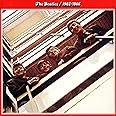

![Help! [LP]](https://images-na.ssl-images-amazon.com/images/I/816hQnNLGFL._AC_UL160_SR160,160_.jpg)











![Speak Now (Taylor's Version)[Orchid Marbled 3 LP]](https://m.media-amazon.com/images/I/51VEmD9krCL.__AC_SR166,182___.jpg)

![It\'s The End Of The World But It\'s A Beautiful Day[Tangerine LP]](https://m.media-amazon.com/images/I/31S8Uw87QEL.__AC_SR166,182___.jpg)


![MAÑANA SERÁ BONITO (BICHOTA SEASON) [Explicit]](https://m.media-amazon.com/images/I/61QGnK8BHsL.__AC_SR166,182___.jpg)


![The Rise and Fall of a Midwest Princess [Explicit]](https://m.media-amazon.com/images/I/51Z5NqkmzQL.__AC_SR166,182___.jpg)

